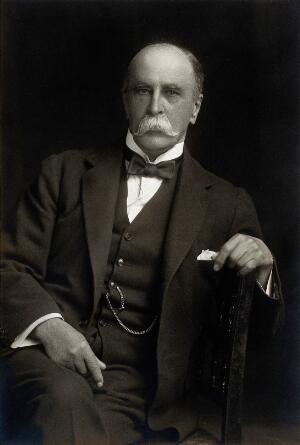Sir William Osler, physician, writer, educator (born 12 July 1849 in Bond Head, Canada West [Ontario]; died 29 December 1919 in Oxford, England). Osler was a physician and professor of medicine who helped revolutionize medical education. He insisted that medical students spend less time in the lecture hall and more time with patients; he also developed the medical residency program. Osler was a prolific writer whose textbook, The Principles and Practice of Medicine (1892), was published in many editions. He was also a bibliophile and historian of medicine whose collection was donated to McGill University.

Osler was raised in Bond Head and in Dundas, Canada West, and educated at the University of Toronto and McGill University, where he graduated with a MD in 1872. After postgraduate training in England and Europe, he began his teaching career at McGill, lecturing in medicine and pathology, publishing extensively and building an international reputation as an astute and humane clinician. In 1884, he accepted an invitation to join the faculty of the University of Pennsylvania; five years later, he became the first professor of medicine at Johns Hopkins University in Baltimore.
By the turn of the century, Osler was probably the best-known physician in the English-speaking world. He achieved this position with a combination of superb practice, excellent and innovative teaching, wide-ranging publication, and association with outstanding colleagues in the most advanced school of its time, Johns Hopkins. His professional interests were unusually wide, but he was particularly expert in diagnosis of diseases of the heart, lungs and blood. His textbook, The Principles and Practice of Medicine, first published in 1892 and frequently revised, was considered authoritative for more than 40 years. His description of the inadequacy of treatment methods for most disorders was a major factor leading to the creation of the Rockefeller Institute for Medical Research in New York City.
Osler was an outgoing, vivacious man given to practical jokes and pranks. He knew how to dispel gloom in the sickroom and how to inspire his patients with hope. He advocated changes in the medical curriculum to decrease the amount of lecturing and increase the time students spent with patients. He was one of those who formalized the methods of postgraduate training for physicians, helping to create the system being followed today. Osler married at age 42, his wife being a direct descendant of Paul Revere. One of their two children died at birth, the other in the First World War.
In 1905, the family left North America for Great Britain, where Osler became Regius professor of medicine at Oxford. The recipient of many honorary degrees, he was created a baronet in 1911. His last years were spent carrying on a busy consultant's practice, writing, teaching and building up his extensive library in the history of medicine, which eventually was bequeathed to McGill. In 1919, Osler died of pneumonia developed after a lengthy trip of consultation. His ashes rest in the Osler Library of Medicine at McGill University. He is still much quoted, and his life remains an exemplar for students and physicians.

 Share on Facebook
Share on Facebook Share on X
Share on X Share by Email
Share by Email Share on Google Classroom
Share on Google Classroom


